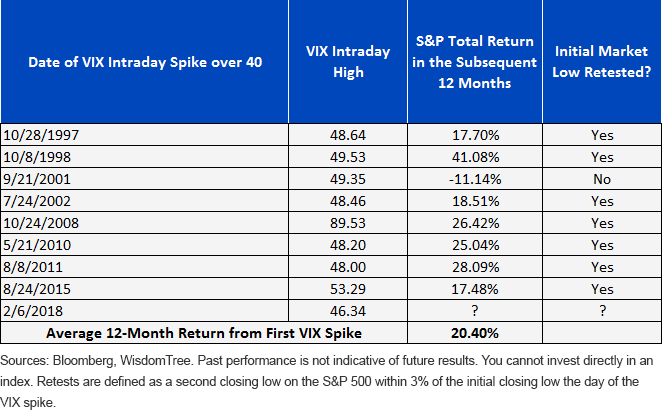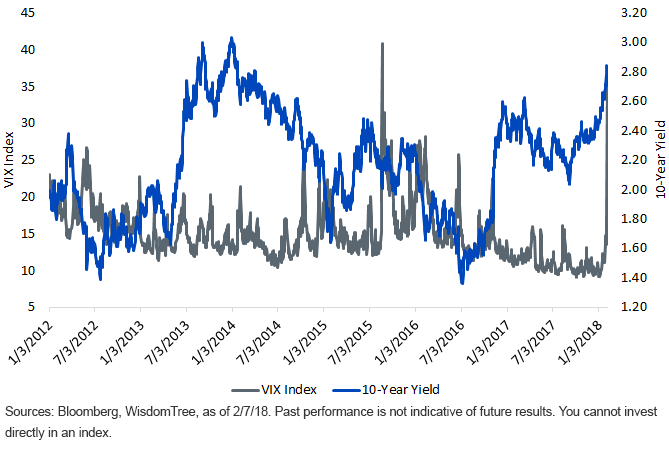The Market Sells Off: Should You Go Away by Valentine’s Day?


Those who were home last week with the flu may have missed the stock market’s equivalent of a lunar eclipse. The Volatility Index (VIX), a measure of market fear, briefly spiked above 50 on Tuesday, February 6—marking only the third time in the last 20 years that this index has soared to that level.
The Dow Jones Industrial Average oscillated within a 2,500-point range between Thursday, February 1, and Tuesday, February 6. In a typical correction, market sell-offs can take weeks or months to unfold. But in today’s environment, a 10% correction can be completed in a matter of hours—and that’s exactly what many investors endured as January turned into February.
What caused the sell-off, and what does it mean for potential returns going forward?
Let me address, first, what has happened historically in the 12 months following a VIX spike. The last time I wrote about this subject, back in October 2015, I showed that in the seven instances where the VIX reached intraday levels above 40 going back to 1997, the S&P 500 returned more than a 20% average return in the subsequent 12 months. And in the year after that most recent August 2015 VIX spike, the S&P 500 returned 17.5%—raising the historical odds for an above-average market return to 88% in the 12 months following a VIX spike.

So, was the recent sell-off a healthy pause—a heart palpitation that reminds you to take your aspirin, exercise and trim some weight? Or was it the first sign that the market may be headed for a more prolonged cardiac arrest?
No one knows with perfect certainty why sudden sell-offs occur, as financial markets reflect the judgments of millions of independent factors. But by observing some of the symptoms, we can get closer to a diagnosis.
First, the sudden move higher in 10-Year Treasury yields likely played a role. Rising long-term interest rates cause assets to be repriced. For stocks, this typically means contractions in P/E ratios. While higher rates may also suggest higher economic growth, which is good for corporate sales growth, higher rates may also be the market’s response to higher wages and rising labor costs, which ultimately can squeeze corporate profit margins. We don’t expect to see any decay in corporate earnings this quarter (more than 80% of the 250 S&P 500 companies that have reported fourth-quarter earnings have beaten consensus estimates1). But going forward, higher government and corporate bond yields can create competition for stocks. With yields on the 10-Year Treasury north of 2.80% (nearly 100 basis points (bps) higher than the dividend yield on the S&P 500), rising rates not only add interest costs to companies and governments, they compete for the new money being put to work by investors. Rising short-term interest rates make buying stocks on margin less appealing. Given that debit balances in customer securities accounts surged to a seven-year high in 2017, sharp market pullbacks can trigger margin calls that can create a second wave of forced selling, which may help to explain part of February 8th 1,000-point drop in the Dow.
In the chart below, we can see how yields on the 10-Year Treasury (in blue) have increased rapidly in recent weeks, approaching levels not seen in nearly five years. Part of the reason for the rising yields has been rising fears of inflation, coupled with large borrowing needs of the U.S. Treasury. This year alone, the U.S. Treasury will need to issue $1 trillion to $1.5 trillion in net new borrowing, reflecting an increase in the baseline deficit along with the new tax cut, maturing debt, and the Federal Reserve’s exit as a net new buyer from the marketplace. (By contrast, 2017 net new borrowing totaled $519 billion.) Of those new issuances, $66 billion were issued on Tuesday, Wednesday and Thursday of last week. Demand was relatively strong for the 3-Year note, but less vigorous for the 10-Year note and the 30-Year Treasury bond.

Second, market sentiment may have been impacted by news that wage pressures are building. Average hourly earnings rose at an annual rate of +2.9%, after upward revisions were made to both November and December. The year-over-year gain for wages is now at the highest reading since 20092. This has implications for inflation expectations. Although the Atlanta Fed has been overly optimistic in the past, estimates for first-quarter GDP growth have remained north of 4% through mid-February. If actual GDP growth comes close to 4% in the first quarter, both long- and short-term interest rates may head higher in 2018 than the market currently expects. The next Fed meeting, led by its new chairman, Jerome Powell, occurs on March 21.
Third, the market sell-off coincided with the release of new information related to congressional investigations into Russian interference in the 2016 election. Declassified information released by both House Intelligence Chairman Devin Nunes and Senate Judiciary Committee Chairman Charles Grassley has created a second narrative on whether foreign agents were used to interfere with the 2016 election and whether laws were broken in the process. Citizens following this political drama on cable television must now digest the plot twists of two diametrically opposed story lines, depending on which channel they’ve tuned into. It’s hard to say what, if any, impact this release had on markets last week —other than the fact the information entered the market’s nervous system precisely at the start of the 10% decline. But because Grassley’s letter to the FBI and the Department of Justice included a criminal referral, it’s possible these investigations could raise the stakes and polarize Washington to ever-greater levels of toxicity. Whether that impacts the normal functions of government, or defies the checks and balances the founders built into the system to restrain its potential abuses, remains to be seen. Early Friday morning, Congress did manage to pass a new budget and raise the debt limit through March 2019. The takeaway for investors is that while Wall Street would prefer to ignore day-to-day machinations in Washington, volatility in D.C. can, in itself, trigger volatility in equity markets.
Conclusion
Historically, investors who used spikes in the VIX as buying opportunities have been rewarded. However, the correction (occurring over just a few days) was, in my view, too quick. The S&P 500 Index will likely need to successfully test the intraday low of 2,532 set on February 9 before the market regains its sea legs. Moreover, the environment we are in now is different in some key respects. Stocks and bonds are selling off together as interest rates rise. And because volatility levels have been unusually low for so long, it will be difficult for stocks to post the type of risk-adjusted returns they have over the past few years, as overall volatility now rises. If you believe interest rates are likely to head higher in the coming weeks (through their high of 2.85% on February 9), then it makes sense to dial down risk and remain cautious.
If that is your view, floating rate U.S. Treasuries are one of WisdomTree’s solutions to help preserve capital and benefit from rising short-term rates. They allow you to shorten effective duration to a matter of weeks and to benefit as the Fed raises short-term interest rates. For more information on how to do so through a WisdomTree exchange-traded fund, please see the WisdomTree Bloomberg Floating Rate Treasury Fund (USFR).
1Bloomberg, as of 2/8/18.
2Bloomberg, as of 2/2/2018
Important Risks Related to this Article
There are risks associated with investing, including possible loss of principal. Securities with floating rates can be less sensitive to interest rate changes than securities with fixed interest rates, but may decline in value. The issuance of floating rate notes by the U.S. Treasury is new and the amount of supply will be limited. Fixed income securities will normally decline in value as interest rates rise. The value of an investment in the Fund may change quickly and without warning in response to issuer or counterparty defaults and changes in the credit ratings of the Fund’s portfolio investments. Due to the investment strategy of this Fund it may make higher capital gain distributions than other ETFs. Please read the Fund’s prospectus for specific details regarding the Fund’s risk profile.


